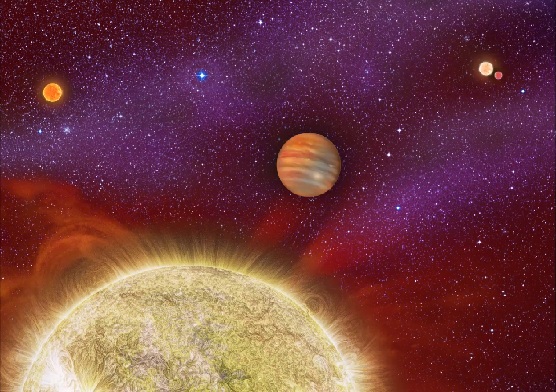| Online: | |
| Visits: | |
| Stories: |

| Story Views | |
| Now: | |
| Last Hour: | |
| Last 24 Hours: | |
| Total: | |
Planet 10 Times the Mass of Jupiter with Four Stars – Newfound Four Star Planetary System (+Video)
The newfound four-star planetary system, called 30 Ari, is located 136 light-years away in the constellation Aries. The system’s gaseous planet is enormous, with 10 times the mass of Jupiter, and it orbits its primary star every 335 days. The primary star has a relatively close partner star, which the planet does not orbit. This pair, in turn, is locked in a long-distance orbit with another pair of stars about 1,670 astronomical units away (an astronomical unit is the distance between Earth and the sun).
.
In recent years, dozens of planets with two or three parent stars have been found, including those with “Tatooine” sunsets reminiscent of the Star Wars movies. Finding planets with multiple parents isn’t too much of a surprise, considering that binary stars are more common in our galaxy than single stars.
“Star systems come in myriad forms.
There can be single stars, binary stars, triple stars, even quintuple star systems,” said Lewis Roberts of JPL, lead author of the new findings appearing in the journal Astronomical Journal. “It’s amazing the way nature puts these things together.”
This is only the second time a planet has been identified in a quadruple star system. While the planet was known before, it was thought to have only three stars, not four. The first four-star planet, KIC 4862625, was discovered in 2013 by citizen scientists using public data from NASA’s Kepler mission.
The latest discovery suggests that planets in quadruple star systems might be less rare than once thought. In fact, recent research has shown that this type of star system, which usually consists of two pairs of twin stars slowly circling each other at great distances, is itself more common than previously believed.
PHYSORG – Read more here: http://phys.org/news/2015-03-planet-reared-parent-stars.htm
Planet ‘Reared’ by Four Parent Stars
http://www.nasa.gov/jpl/planet-reared-by-four-parent-stars/
Journal reference: Astronomical Journal
http://iopscience.iop.org/1538-3881/149/4/118/article
Images credit: Dirk Terrell, Karen Teramura, UH IfA
& NASA/JPL-Caltech

Image Credit: Karen Teramura, UH IfA



